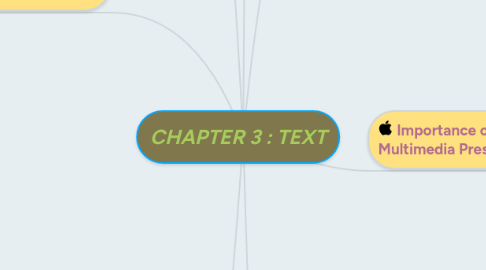
1. Using Text Elements In Multimedia Presentation
1.1. Menus for navigation
1.1.1. navigates through content using a menu
1.1.2. consist of a text list of topics
1.2. Interactive buttons
1.2.1. clickable object that executes a command when activated
1.2.2. user can create their own buttons from bitmaps and graphics
1.3. Symbols and Icons
1.3.1. concentrate text in the form of stand-alone graphic contructs
1.3.2. used to convey meaningful messages
1.3.3. used to convey human emotions, called emoticons
1.3.4. Icons are objects and processes
1.4. Fields for reading
1.4.1. reading a hard copy is easier and faster than reading from the computer screen
1.4.2. document can be printed in portrait or landscape
1.4.3. taller-than-wide printed document called portrait
1.4.4. wider-than-tall to monitorn called landscape
1.5. HTML documents
1.5.1. Hypertext Markup Language
1.5.2. used to create web pages
1.5.3. documents are marked using tags
1.5.4. advance form of HTML is DHTML
1.5.5. DHTML is Dynamic Hypertext Markup Language
1.5.6. used together to create interactive and animated web sites
1.5.7. DHTML uses:
1.5.7.1. static HTML
1.5.7.2. client side scripting language- as Javascript
1.5.7.3. Cascading Style Sheets (CSS)
1.6. Some of the commonly used tags are:
1.6.1. The <B> text boldface
1.6.2. The <OL> creating an order list
1.6.3. The <IMG> inserting images
1.7. Choosing text fonts
1.7.1. Consider legibility and readability
1.7.2. Avoid too many faces
1.7.3. Use color purposefully
1.7.4. Use anti-aliased text
1.7.5. Use drop caps and initial caps for accent
1.7.6. Minimize centered text
1.7.7. Use white space
1.7.8. Use animated text to grab attention
2. Computer and Text
2.1. Bitmap font and Vector Font
2.1.1. Fonts can either be stored as bitmapped or vector
2.1.2. Bitmaps font consist of a matrix of dots or pixels representing the image.
2.1.2.1. File size increases as more sizes are added.
2.1.2.2. Required a lot of memory
2.1.2.3. Non-scalable
2.1.3. Vector fonts drawing use instruction and mathematical formulae to describe each glyph
2.1.4. can draw any size by scaling the vector drawing primitives mathematically
2.1.4.1. File size is much smaller than bitmaps
2.1.4.2. True Type, Open Type and PostScript are vector fonts format
2.2. Character sets
2.2.1. Computer can only understand numbers, so an ASCII (American Standard Code For Information Interchange) represent of character
2.2.2. unique 7-bit binary code word, that there are 128(2^7) alternative characters
2.3. Rasterization
2.3.1. process of converting text from a vector description to a raster or bitmap description
2.3.2. Jaggies are the jagged edges you see when a bitmapped image is resized
3. Font Editing And Design Tools
3.1. Font lab, Ltd
3.2. Creating attractive texts
3.3. Fontographer
3.3.1. Specialized graphics editor
3.3.2. It is compatible with both Macintosh and Windows platforms
3.3.3. used to develop Postscript, True Type, and Open Type fonts
3.3.4. can modify existing typefaces and incorporate Postscript artwork
4. Importance of Text In a Multimedia Presentation:
4.1. simplest of data types
4.2. requires the least amount of storage
4.3. Form of:
4.3.1. symbols
4.3.2. words
4.3.3. sentences
4.3.4. paragraph
4.4. vital element of multimedia menus navigation systems,and content
5. Understanding Fonts & Typefaces
5.1. Typefaces
5.1.1. family of graphic characters, often within many type sizes and styles.
5.1.2. Example: Bookman Old Style
5.2. Font
5.2.1. collection of characters of a single size and style belonging to a particular typeface family.
5.2.2. Example: Arial 18 point BOLD
5.3. Fonts and Typefaces includes the following:
5.3.1. Font Styles
5.3.1.1. Boldface
5.3.1.2. Italic
5.3.1.3. Underlining
5.3.1.4. Outlining
5.3.2. Font Terminology
5.3.2.1. Baselines
5.3.2.1.1. character are arranged
5.3.2.2. Cap height
5.3.2.2.1. capital letter
5.3.2.3. x-height
5.3.2.3.1. baseline and top of lower-case letter x
5.3.2.4. Ascenders/descenders
5.3.2.4.1. above the x-height/drop below the baseline
5.3.2.5. Kerning
5.3.2.5.1. certain pairs of letter
5.3.2.6. Tracking
5.3.2.6.1. group of letters
5.3.3. Cases
5.3.3.1. capitalized letter as uppercase
5.3.3.2. small letter as lowercase
5.3.3.3. uppercase letter in the middle of a word as intercap or Camelcase
5.3.4. Serif
5.3.4.1. little decoration at the end of a letter stroke
5.3.4.2. printed media or documents that have large quantities of text
5.3.5. Sans serif
5.3.5.1. do not have decoration
5.3.5.2. headlines and bold statement
6. Hypertext vs Hypermedia
6.1. Hypertext
6.1.1. Links to other text
6.1.2. Subset of hypermedia
6.1.3. Invented by Tan Nelson around 1965
6.2. Hypermedia
6.2.1. Not constrained to be text-based
6.2.2. Graphic, images, and especially the continuous media - sound and video
6.3. A hypertext or hypermedia systems enables the user to navigate through text in a nonlinear way
7. Hypermedia structure
7.1. Navigating hypermedia structures
7.1.1. Simplest way To navigate is Via buttons
7.2. Hypermedia structures
7.2.1. Links
7.2.1.1. Connection between conceptual elements
7.2.1.2. The navigation pathways and menus
7.2.2. Nodes
7.2.2.1. Accessible topics, documents, messages, and content elements
7.2.2.2. Nodes and links form the backbone of a knowledge access system
7.2.3. Anchors
7.2.3.1. Reference from one document to another document, image, sound, or file on the Web
7.3. Hypertext systems are used for:
7.3.1. Electronic publishing and reference works
7.3.2. Technical documentation
7.3.3. Educational courseware
7.3.4. Interactive kiosks
7.3.5. Electronic catalogs
